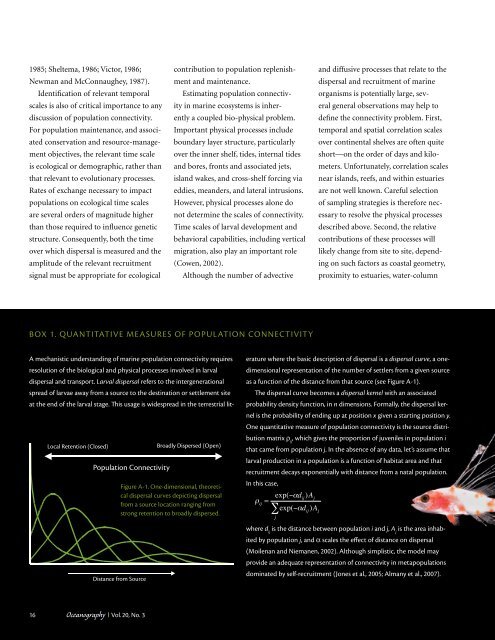Population Connectivity in Marine Systems
Population Connectivity in Marine Systems
Population Connectivity in Marine Systems
Create successful ePaper yourself
Turn your PDF publications into a flip-book with our unique Google optimized e-Paper software.
1985; Sheltema, 1986; Victor, 1986;<br />
Newman and McConnaughey, 1987).<br />
Identification of relevant temporal<br />
scales is also of critical importance to any<br />
discussion of population connectivity.<br />
For population ma<strong>in</strong>tenance, and associated<br />
conservation and resource-management<br />
objectives, the relevant time scale<br />
is ecological or demographic, rather than<br />
that relevant to evolutionary processes.<br />
Rates of exchange necessary to impact<br />
populations on ecological time scales<br />
are several orders of magnitude higher<br />
than those required to <strong>in</strong>fluence genetic<br />
structure. Consequently, both the time<br />
over which dispersal is measured and the<br />
amplitude of the relevant recruitment<br />
signal must be appropriate for ecological<br />
BOx 1. QuANtitAtiVe MeASureS OF POPulAtiON CONNeCtiVity<br />
A mechanistic understand<strong>in</strong>g of mar<strong>in</strong>e population connectivity requires<br />
resolution of the biological and physical processes <strong>in</strong>volved <strong>in</strong> larval<br />
dispersal and transport. Larval dispersal refers to the <strong>in</strong>tergenerational<br />
spread of larvae away from a source to the dest<strong>in</strong>ation or settlement site<br />
at the end of the larval stage. This usage is widespread <strong>in</strong> the terrestrial lit-<br />
16<br />
Local Retention (Closed)<br />
<strong>Population</strong> <strong>Connectivity</strong><br />
Distance from Source<br />
Oceanography Vol. 20, No. 3<br />
Broadly Dispersed (Open)<br />
Figure A-1. One-dimensional, theoretical<br />
dispersal curves depict<strong>in</strong>g dispersal<br />
from a source location rang<strong>in</strong>g from<br />
strong retention to broadly dispersed.<br />
contribution to population replenishment<br />
and ma<strong>in</strong>tenance.<br />
Estimat<strong>in</strong>g population connectivity<br />
<strong>in</strong> mar<strong>in</strong>e ecosystems is <strong>in</strong>herently<br />
a coupled bio-physical problem.<br />
Important physical processes <strong>in</strong>clude<br />
boundary layer structure, particularly<br />
over the <strong>in</strong>ner shelf, tides, <strong>in</strong>ternal tides<br />
and bores, fronts and associated jets,<br />
island wakes, and cross-shelf forc<strong>in</strong>g via<br />
eddies, meanders, and lateral <strong>in</strong>trusions.<br />
However, physical processes alone do<br />
not determ<strong>in</strong>e the scales of connectivity.<br />
Time scales of larval development and<br />
behavioral capabilities, <strong>in</strong>clud<strong>in</strong>g vertical<br />
migration, also play an important role<br />
(Cowen, 2002).<br />
Although the number of advective<br />
and diffusive processes that relate to the<br />
dispersal and recruitment of mar<strong>in</strong>e<br />
organisms is potentially large, several<br />
general observations may help to<br />
def<strong>in</strong>e the connectivity problem. First,<br />
temporal and spatial correlation scales<br />
over cont<strong>in</strong>ental shelves are often quite<br />
short—on the order of days and kilometers.<br />
Unfortunately, correlation scales<br />
near islands, reefs, and with<strong>in</strong> estuaries<br />
are not well known. Careful selection<br />
of sampl<strong>in</strong>g strategies is therefore necessary<br />
to resolve the physical processes<br />
described above. Second, the relative<br />
contributions of these processes will<br />
likely change from site to site, depend<strong>in</strong>g<br />
on such factors as coastal geometry,<br />
proximity to estuaries, water-column<br />
erature where the basic description of dispersal is a dispersal curve, a one-<br />
dimensional representation of the number of settlers from a given source<br />
as a function of the distance from that source (see Figure A-1).<br />
The dispersal curve becomes a dispersal kernel with an associated<br />
probability density function, <strong>in</strong> n dimensions. Formally, the dispersal ker-<br />
nel is the probability of end<strong>in</strong>g up at position x given a start<strong>in</strong>g position y.<br />
One quantitative measure of population connectivity is the source distri-<br />
bution matrix ρ ij , which gives the proportion of juveniles <strong>in</strong> population i<br />
that came from population j. <strong>in</strong> the absence of any data, let’s assume that<br />
larval production <strong>in</strong> a population is a function of habitat area and that<br />
recruitment decays exponentially with distance from a natal population.<br />
<strong>in</strong> this case,<br />
where d is the distance between population i and j, A is the area <strong>in</strong>hab-<br />
ij j<br />
ited by population j, and α scales the effect of distance on dispersal<br />
(Moilenan and Niemanen, 2002). Although simplistic, the model may<br />
provide an adequate representation of connectivity <strong>in</strong> metapopulations<br />
dom<strong>in</strong>ated by self-recruitment (Jones et al., 2005; Almany et al., 2007).
















